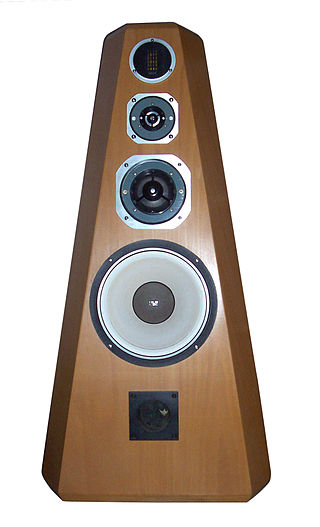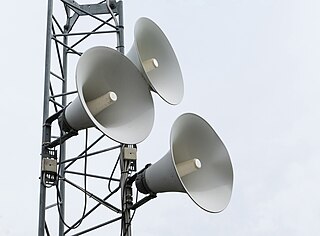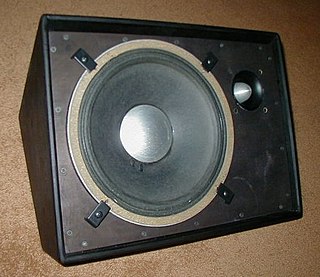
An amplifier, electronic amplifier or (informally) amp is an electronic device that can increase the magnitude of a signal. It is a two-port electronic circuit that uses electric power from a power supply to increase the amplitude of a signal applied to its input terminals, producing a proportionally greater amplitude signal at its output. The amount of amplification provided by an amplifier is measured by its gain: the ratio of output voltage, current, or power to input. An amplifier is defined as a circuit that has a power gain greater than one.

High fidelity is the high-quality reproduction of sound. It is popular with audiophiles and home audio enthusiasts. Ideally, high-fidelity equipment has inaudible noise and distortion, and a flat frequency response within the human hearing range.

X10 is a protocol for communication among electronic devices used for home automation (domotics). It primarily uses power line wiring for signaling and control, where the signals involve brief radio frequency bursts representing digital information. A wireless radio-based protocol transport is also defined.

A loudspeaker is an electroacoustic transducer that converts an electrical audio signal into a corresponding sound. A speaker system, also often simply referred to as a speaker or loudspeaker, comprises one or more such speaker drivers, an enclosure, and electrical connections possibly including a crossover network. The speaker driver can be viewed as a linear motor attached to a diaphragm which couples that motor's movement to motion of air, that is, sound. An audio signal, typically from a microphone, recording, or radio broadcast, is amplified electronically to a power level capable of driving that motor in order to reproduce the sound corresponding to the original unamplified electronic signal. This is thus the opposite function to the microphone; indeed the dynamic speaker driver, by far the most common type, is a linear motor in the same basic configuration as the dynamic microphone which uses such a motor in reverse, as a generator.

An audio power amplifier amplifies low-power electronic audio signals, such as the signal from a radio receiver or an electric guitar pickup, to a level that is high enough for driving loudspeakers or headphones. Audio power amplifiers are found in all manner of sound systems including sound reinforcement, public address, home audio systems and musical instrument amplifiers like guitar amplifiers. It is the final electronic stage in a typical audio playback chain before the signal is sent to the loudspeakers.
An audiophile is a person who is enthusiastic about high-fidelity sound reproduction. An audiophile seeks to reproduce recorded music to achieve high sound quality, typically in a quiet listening space and in a room with good acoustics.

A mixing console or mixing desk is an electronic device for mixing audio signals, used in sound recording and reproduction and sound reinforcement systems. Inputs to the console include microphones, signals from electric or electronic instruments, or recorded sounds. Mixers may control analog or digital signals. The modified signals are summed to produce the combined output signals, which can then be broadcast, amplified through a sound reinforcement system or recorded.

Audio system measurements are a means of quantifying system performance. These measurements are made for several purposes. Designers take measurements so that they can specify the performance of a piece of equipment. Maintenance engineers make them to ensure equipment is still working to specification, or to ensure that the cumulative defects of an audio path are within limits considered acceptable. Audio system measurements often accommodate psychoacoustic principles to measure the system in a way that relates to human hearing.

A public address system is an electronic system comprising microphones, amplifiers, loudspeakers, and related equipment. It increases the apparent volume (loudness) of a human voice, musical instrument, or other acoustic sound source or recorded sound or music. PA systems are used in any public venue that requires that an announcer, performer, etc. be sufficiently audible at a distance or over a large area. Typical applications include sports stadiums, public transportation vehicles and facilities, and live or recorded music venues and events. A PA system may include multiple microphones or other sound sources, a mixing console to combine and modify multiple sources, and multiple amplifiers and loudspeakers for louder volume or wider distribution.

The Covox Speech Thing is an external digital-to-analog converter (DAC) that plugs into the parallel printer port of a PC. It converts 8-bit digital sound using a simple R-2R resistor ladder into an analog signal output.
PS Audio is an American company specializing in high-fidelity audio components equipment for audiophiles and the sound recording industry. It currently produces audio amplifiers, preamplifiers, power related products, digital-to-analog converters, streaming audio, music management software and cables.

An intercom, also called an intercommunication device, intercommunicator, or interphone, is a stand-alone voice communications system for use within a building, small collection of buildings or portably within a small coverage area, which functions independently of the public telephone network. Intercoms are generally mounted permanently in buildings and vehicles, but can also be detachable and portable. Intercoms can incorporate connections to public address loudspeaker systems, walkie talkies, telephones, and other intercom systems. Some intercom systems incorporate control of devices such as signal lights and door latches.
A television transmitter is a transmitter that is used for terrestrial (over-the-air) television broadcasting. It is an electronic device that radiates radio waves that carry a video signal representing moving images, along with a synchronized audio channel, which is received by television receivers belonging to a public audience, which display the image on a screen. A television transmitter, together with the broadcast studio which originates the content, is called a television station. Television transmitters must be licensed by governments, and are restricted to a certain frequency channel and power level. They transmit on frequency channels in the VHF and UHF bands. Since radio waves of these frequencies travel by line of sight, they are limited by the horizon to reception distances of 40–60 miles depending on the height of transmitter station.

Sound Blaster Live! is a PCI add-on sound card from Creative Technology Limited for PCs. Moving from ISA to PCI allowed the card to dispense with onboard memory, storing digital samples in the computer's main memory and then accessing them in real time over the bus. This allowed for a much wider selection of, and longer playing, samples. It also included higher quality sound output at all levels, quadrophonic output, and a new MIDI synthesizer with 64 sampled voices. The Live! was introduced on August 11, 1998 and variations on the design remained Creative's primary sound card line into the early 2000's.
Digital speakers or digital sound reconstruction (DSR) systems are a form of loudspeaker technology. Not to be confused with modern digital formats and processing, they are yet to be developed as a mature technology, having been experimented with extensively by Bell Labs as far back as the 1920s, but not realized as commercial products.
CobraNet is a combination of software, hardware, and network protocols designed to deliver uncompressed, multi-channel, low-latency digital audio over a standard Ethernet network. Developed in the 1990s, CobraNet is widely regarded as the first commercially successful audio-over-Ethernet implementation.

Constant-voltage speaker systems refer to networks of loudspeakers which are connected to an audio amplifier using step-up and step-down transformers to simplify impedance calculations and to minimize power loss over the speaker cables. They are more appropriately called high-voltage audio distribution systems. The voltage is constant only in the sense that at full power, the voltage in the system does not depend on the number of speakers driven. Constant-voltage speaker systems are also commonly referred to as 25-, 70-, 70.7-, 100 or 210-volt speaker systems; distributed speaker systems; or high-impedance speaker systems. In Canada and the US, they are most commonly referred to as 70-volt speakers. In Europe, the 100 V system is the most widespread, with amplifier and speaker products being simply labeled with 100 V.
Crown International, or Crown Audio, is an American manufacturer of audio electronics, and is a subsidiary of Harman International Industries, which has been part of South Korea-based Samsung Electronics since 2017. Today, the company is known primarily for its power amplifiers, but has also manufactured microphones, loudspeakers, and a line of commercial audio products, as well as digital audio networking products.

A stage monitor system is a set of performer-facing loudspeakers called monitor speakers, stage monitors, floor monitors, wedges, or foldbacks on stage during live music performances in which a sound reinforcement system is used to amplify a performance for the audience. The monitor system allows musicians to hear themselves and fellow band members clearly.

The Quad Electrostatic Loudspeaker (ESL) is the world's first production full-range electrostatic loudspeaker, launched in 1957 by Quad Electroacoustics, then known as the Acoustical Manufacturing Co. Ltd. The speaker is shaped somewhat like a home electric radiator curved slightly on the vertical axis. They are widely admired for their clarity and precision, but known to be difficult speakers to run and maintain.













